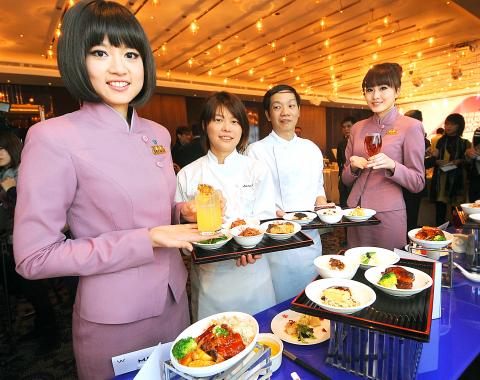China Airlines Ltd (CAL, 中華航空), the nation’s largest carrier, is looking to launch new routes and increase flights on some routes to compete with budget airlines, its president said yesterday.
Despite the competition, the airline industry may have also benefited from the entry of low-cost carriers, as they have boosted passenger revenues, CAL president Sun Hung-hsiang (孫洪祥) told reporters on the sidelines of a press conference on the company’s partnership with W Taipei.
“In the wake of various low-cost carriers entering the market over the past few years, passenger demand has increased,” he said.

Photo: Fang Pin-chao, Taipei Times
The stronger demand helped regular carriers, like CAL, to expand some routes and flights, Sun added.
Using the Malaysia route as an example, Sun said CAL plans to increase flights between Taipei and Kuala Lumpur this year, as the flourishing of Malaysia-based budget carrier AirAsia has increased the number of tourists coming from Malaysia to Taiwan.
CAL may change its Hawaii flights to non-stop flights in June or July, as the US visa waiver program has boosted Taiwanese interest in visiting Hawaii, he said.
However, competition from low-cost carriers has also made regular airlines cautious about raising ticket prices.
CAL will experiment with a new marketing strategy over the next month of selling some tickets cheaper online, mostly on routes with lower passenger loading rates, he said.
The average ticket price for a regular carrier would be 10 percent to 15 percent higher than that of a low-cost carrier, Sun said.
Meanwhile, CAL and W Taipei — a luxury hotel backed by Uni-President Group (統一集團) — have joined together to launch new in-flight cuisine, with four contemporary menus created by chefs from the hotel’s YEN Chinese restaurant (紫豔中餐廳).
The menus will be served in first-class and business-class on routes from Taipei to the US, Japan and China, CAL said in a statement.
Four signature cocktails from W Taipei’s Woobar will also be served onboard long-haul flights, the statement said.
CAL posted a net profit of NT$384.31 million (US$13.23 million), or NT$0.08 per share, in the first three quarters of last year, up about 60 percent from NT$0.05 in the same period in 2011, the airline said in a stock exchange filing.

WEAKER ACTIVITY: The sharpest deterioration was seen in the electronics and optical components sector, with the production index falling 13.2 points to 44.5 Taiwan’s manufacturing sector last month contracted for a second consecutive month, with the purchasing managers’ index (PMI) slipping to 48, reflecting ongoing caution over trade uncertainties, the Chung-Hua Institution for Economic Research (CIER, 中華經濟研究院) said yesterday. The decline reflects growing caution among companies amid uncertainty surrounding US tariffs, semiconductor duties and automotive import levies, and it is also likely linked to fading front-loading activity, CIER president Lien Hsien-ming (連賢明) said. “Some clients have started shifting orders to Southeast Asian countries where tariff regimes are already clear,” Lien told a news conference. Firms across the supply chain are also lowering stock levels to mitigate

Six Taiwanese companies, including contract chipmaker Taiwan Semiconductor Manufacturing Co (TSMC, 台積電), made the 2025 Fortune Global 500 list of the world’s largest firms by revenue. In a report published by New York-based Fortune magazine on Tuesday, Hon Hai Precision Industry Co (鴻海精密), also known as Foxconn Technology Group (富士康科技集團), ranked highest among Taiwanese firms, placing 28th with revenue of US$213.69 billion. Up 60 spots from last year, TSMC rose to No. 126 with US$90.16 billion in revenue, followed by Quanta Computer Inc (廣達) at 348th, Pegatron Corp (和碩) at 461st, CPC Corp, Taiwan (台灣中油) at 494th and Wistron Corp (緯創) at

IN THE AIR: While most companies said they were committed to North American operations, some added that production and costs would depend on the outcome of a US trade probe Leading local contract electronics makers Wistron Corp (緯創), Quanta Computer Inc (廣達), Inventec Corp (英業達) and Compal Electronics Inc (仁寶) are to maintain their North American expansion plans, despite Washington’s 20 percent tariff on Taiwanese goods. Wistron said it has long maintained a presence in the US, while distributing production across Taiwan, North America, Southeast Asia and Europe. The company is in talks with customers to align capacity with their site preferences, a company official told the Taipei Times by telephone on Friday. The company is still in talks with clients over who would bear the tariff costs, with the outcome pending further

NEGOTIATIONS: Semiconductors play an outsized role in Taiwan’s industrial and economic development and are a major driver of the Taiwan-US trade imbalance With US President Donald Trump threatening to impose tariffs on semiconductors, Taiwan is expected to face a significant challenge, as information and communications technology (ICT) products account for more than 70 percent of its exports to the US, Chung-Hua Institution for Economic Research (CIER, 中華經濟研究院) president Lien Hsien-ming (連賢明) said on Friday. Compared with other countries, semiconductors play a disproportionately large role in Taiwan’s industrial and economic development, Lien said. As the sixth-largest contributor to the US trade deficit, Taiwan recorded a US$73.9 billion trade surplus with the US last year — up from US$47.8 billion in 2023 — driven by strong